
By Eric Collins, Co-Expedition Principal Investigators, University of Alaska Fairbanks
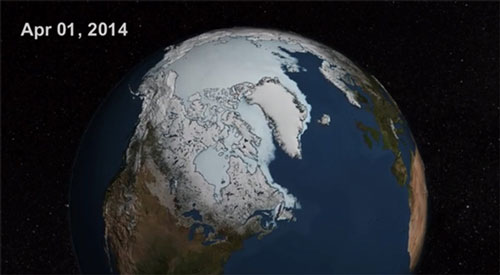
Figure 1: Sea ice extent in the Arctic. Image courtesy of the National Snow and Ice Data Center. Download larger version (jpg, 52 KB).
Sea ice is a thin sheet of frozen seawater covering the ocean at high latitudes, with an average thickness of about 6 feet (2 meters) and a maximum thickness of about 30 feet (10 meters).
Sea ice is a seasonally, spatially, and biologically dynamic habitat that has existed on Earth continuously for about the past 40 million years. While it is now confined to the poles, earlier cold periods in Earth’s history may have allowed sea ice to extend all the way down to the equator.
Perhaps surprisingly, the oldest sea ice on Earth is less than 20 years old, so it is not used for reconstruction of global climate, like glacial ice, but it is a sensitive indicator of climate change. We know that the thickness and areal extent of sea ice in the Arctic is decreasing rapidly as a consequence of atmospheric and ocean warming.
In the modern day, sea ice in the northern hemisphere fills the entire Arctic Ocean during winter and spills out into the Pacific and Atlantic Oceans, covering an area 50 percent larger than that of the United States [Figure 1]. In the summer, the ice shrinks back into the Arctic Ocean and currently only about 30 percent of the ice survives the summer melt. Scientists predict that in the next 30-50 years, the fraction of Arctic sea ice surviving the summer will shrink to nearly zero.
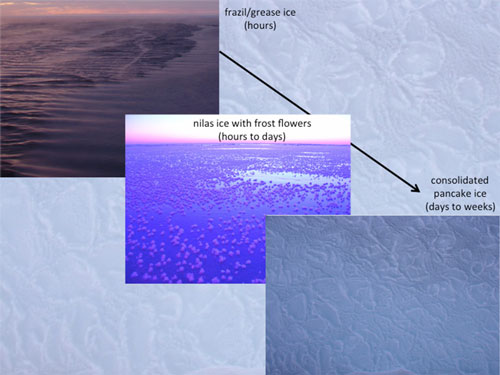
Figure 2: Sea ice growth history. Image courtesy of Eric Collins. Download larger version (jpg, 127 KB).
Sea ice forms when the air temperature drops below the freezing point of seawater, which is about 28°F (-2°C). Small crystals called ‘frazil’ begin forming in the water, which then float to the surface and freeze together into ‘nilas.’ Nilas ice floes may bump into each other to form ‘pancake’ ice, which is thick enough to dampen the physical mixing of the water and the ice. Orderly ice growth then continues at a pace of perhaps 3/8 inch (1 centimeters) per day if temperatures remain very cold (e.g., below 0°F or -20°C).
Snowfall on top of the ice can slow this growth by insulating the ice from the cold. In any case, there is a strong gradient in ice temperature from the surface of the ice, which can reach temperatures of -40°F (-40°C) to the bottom of the ice, which remains always at the freezing point of the seawater.
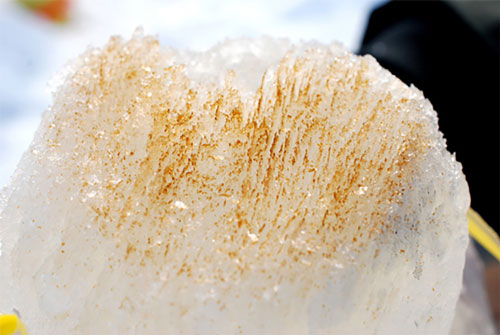
Figure 3: Sea ice algae from Barrow, Alaska. Image courtesy of Eric Collins. Download larger version (jpg, 126 KB).
Despite the extremely cold conditions that lead to the formation of the ice, a huge diversity of life depends on the ice to exist. Microbes, including algae that live in dense mats on the underside of the ice, make up the bulk of the biomass within the ice, and act as the base of the sea ice food web [Figure 3]. Parasitic fungi can infect ice algae and may limit their growth [see https://icefungi.wordpress.com ]. Bacteria within the ice serve to degrade dead organisms and recycle their nutrients for use by the ice algae.
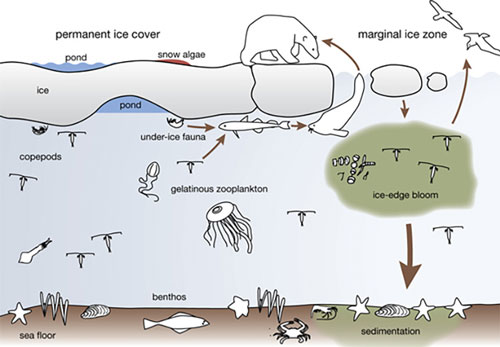
Figure 4: Sea ice food web. Image courtesy of CAFF. 2010. Arctic Biodiversity Trends: Selected indicators of change. Download larger version (jpg, 80 KB).
Zooplankton, including crustaceans like copepods, eat the ice algae and are then eaten by larger animals. Polar bears, seals, walruses, whales, birds, and other animals make use of the ice for feeding, breeding, and protection [Figure 4].
Ice algae can also be important contributors to the benthic food web because they tend to sink rapidly to the bottom in the summer when the ice melts and they are released into the water column.
In this project, we are studying the diversity and adaptations of the microbes in sea ice using DNA sequencing techniques that allow us to explore this hidden world.
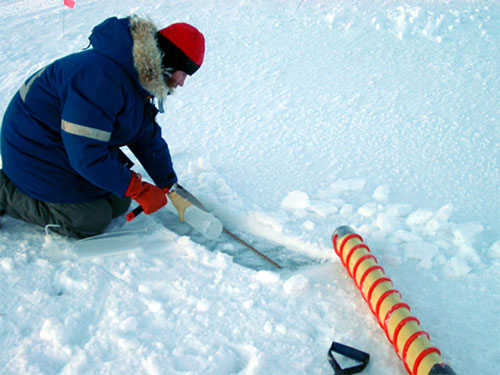
Figure 5: Sterilely sectioning a sea ice core in Franklin Bay, Canada. Image courtesy of Eric Collins. Download larger version (jpg, 156 KB).
Our basic method is as follows:
Right now, we do steps 1-4 in the field, either at a remote field station or from an icebreaker, then we store the filters at ultralow temperature (-110°F, -80°>C) to prevent degradation of the DNA. Then we take the filters back to the lab at the University of Alaska Fairbanks to extract the DNA and do the sequencing.
We can imagine that in the not-too-distant future (within 10 years) we will take a DNA sequencer into the field with us to obtain instantaneous data. In the more distant future (10-20 years) DNA sequencers will be installed on moorings or autonomous underwater vehicles to collect real-time data on the diversity of microbes in the environment.
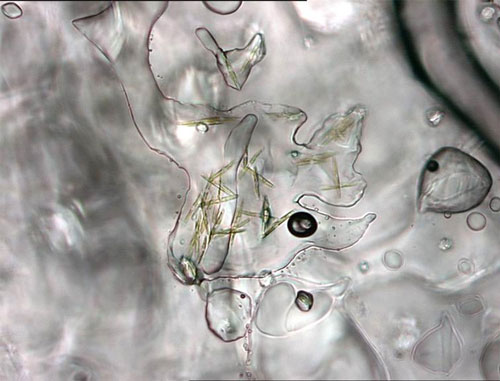
Figure 6: Sea ice algae within brine pockets. Image courtesy of Christopher Krembs. Download larger version (jpg, 123 KB).